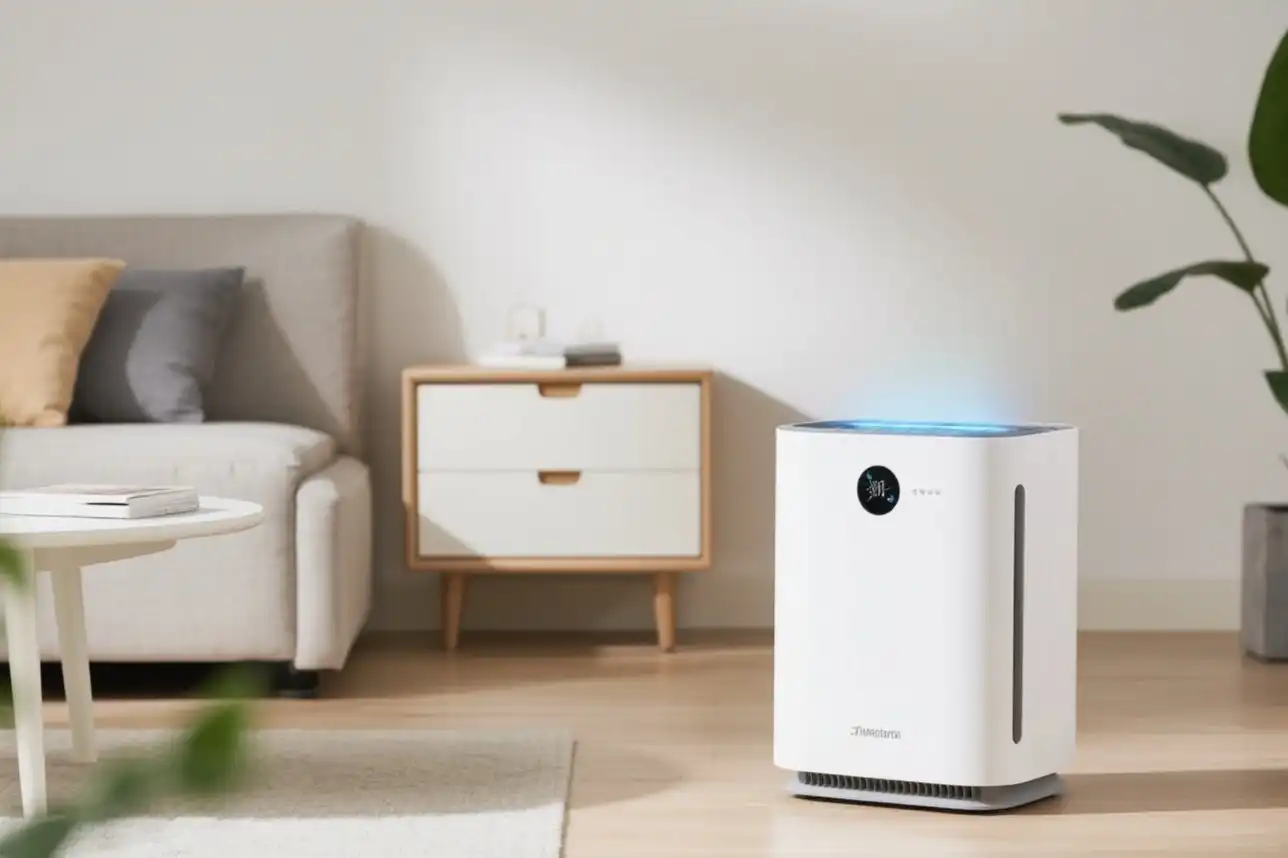
You want clean air in your bedroom, living room, or office. To get the best results, you need an air purifier that matches your room size. Scientific studies show that when the Clean Air Delivery Rate (CADR) fits the space, the machine can remove dust and allergens more effectively. CADR measures how much clean air the purifier gives you every hour. Air changes per hour (ACH) tells you how often the air is replaced. If you use a unit that is too small, it will not clean the air well and may waste energy.
Quick Reference Table:
Room Size Recommended CADR (m³/h) Air Changes Per Hour Small (up to 200 sq ft) 100-200 4-5 Medium (200-400 sq ft) 200-300 3-4 Large (400-600 sq ft) 300+ 2-3
Key Takeaways
- First, measure your room’s length and width. This helps you find the square footage. Do this before you pick an air purifier.
- Use this rule: choose an air purifier with a CADR that is at least two-thirds of your room’s square footage. This helps clean the air well.
- Pick the right air purifier size for your room. Bedrooms need quiet units. Living rooms need a higher CADR. Offices need filters for dust and chemicals.
- Put the air purifier close to where you spend time. Do not put it near walls or in corners. This helps clean the air evenly and quietly.
- Change the filters on time. Do not buy units that are too small or too big. This saves energy and keeps the air clean.
Air Purifier Sizing Guide
Quick Reference Table
Choosing the right size air purifier starts with knowing your room size and the Clean Air Delivery Rate (CADR) you need. The CADR tells you how much clean air the machine can deliver each hour. You can use the table below to match your room size to the recommended minimum CADR. This helps you find a model that will clean your air well.
| Room Size | Approximate Coverage (sq ft) | Recommended Minimum CADR |
|---|---|---|
| Small | Up to ~275 | ~183 |
| Medium | Up to ~375 | ~250 |
| Large | Up to ~709 – 888 | ~473 – 592 |
| Extra Large | Up to ~1361 | ~907 |
Tip: For most rooms with standard 8-foot ceilings, you can use a simple rule: the CADR should be at least two-thirds of your room’s square footage. For example, if your room is 300 square feet, look for a CADR of at least 200.
Room Types Overview
You need to consider the type of room when picking an air purifier. Bedrooms, living rooms, and offices all have different sizes and air quality needs.
- Bedrooms:
Most bedrooms in homes are between 100 and 224 square feet. Master bedrooms are larger, often around 224 square feet. Smaller bedrooms, like those for kids or guests, are about 100 to 132 square feet. Bedrooms often have high dust mite levels and need quiet air purifiers. Place the unit close to where you sleep for best results. - Living Rooms:
Living rooms are usually bigger than bedrooms. They can range from 192 to 600 square feet or more. These rooms often connect to other spaces, so you may need a larger air purifier or even more than one. Living rooms have more dust, pet dander, and odors from cooking or furniture. Choose a model with a higher CADR and multi-stage filters. - Offices:
Home offices can be small (about 80 square feet) or medium to large (up to 252 square feet). Offices may have dust, printer particles, and chemicals from office supplies. Use the same CADR rule as for bedrooms and living rooms. Make sure the air purifier fits the space and is not too loud for work.
| Room Type | Size Category | Typical Dimensions (feet) | Typical Size (sq ft) |
|---|---|---|---|
| Bedroom | Small | 9 x 10 | 90 |
| Bedroom | Master | 14 x 16 | 224 |
| Living Room | General | 12 x 16 to 20 x 30 | 192 – 600 |
| Home Office | Small | 8 x 10 | 80 |
| Home Office | Medium | 12 x 14 | 168 |
| Home Office | Large | 14 x 18 | 252 |
Rule of Thumb for Sizing
You can follow these steps to find the right CADR for your room:
- Measure your room’s length and width in feet. Multiply them to get the square footage.
- For rooms with standard ceilings, multiply the square footage by 2/3. This gives you the minimum CADR you need.
- If your room has high ceilings or special air quality needs, you may need a higher CADR.
Note: For large or open spaces, you may need more than one air purifier. Place them in different parts of the room to make sure all the air gets cleaned. Using multiple units helps if you have allergies or if the space has a lot of people or pets. Make sure each unit matches the size of the area it covers.
- In open layouts, one powerful air purifier can sometimes cover the whole space.
- In very large rooms, two or more units placed far apart can clean the air faster and more evenly.
- Do not use too many units, as this can make the room noisy and waste energy.
By following these guidelines, you can choose an air purifier that fits your bedroom, living room, or office. This helps you breathe cleaner air and stay healthy.
Room Measurement
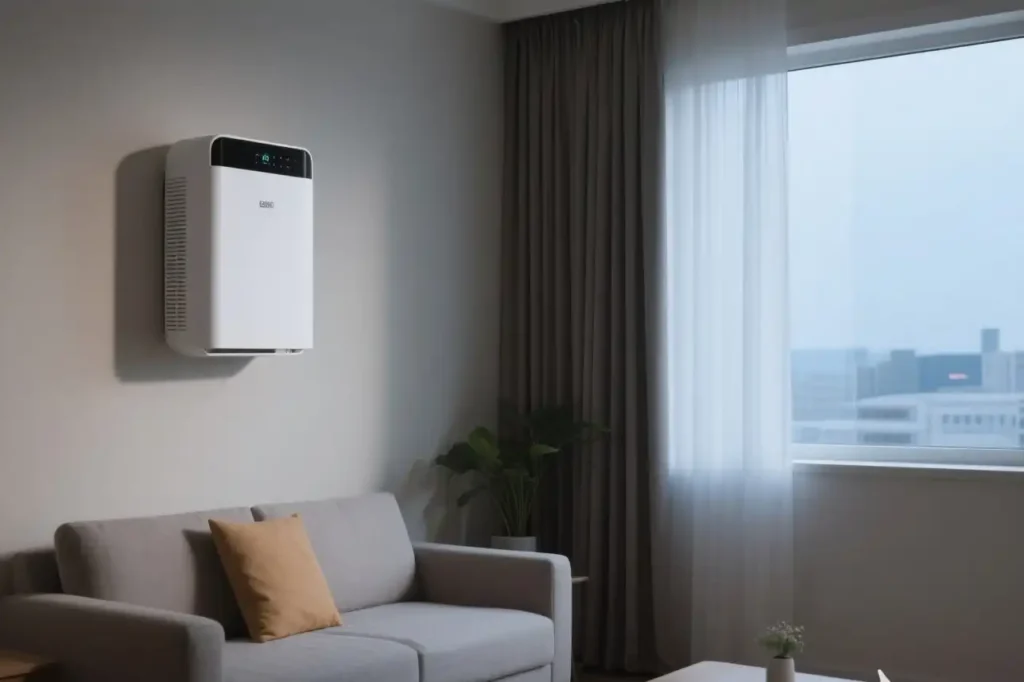
Measuring Square Footage
Getting the right room size is the first step to choosing the best air cleaning solution. You need to measure your room’s length and width. Use a tape measure for the most accurate results. Follow these steps:
- Gather your tools: tape measure, notepad, pen, and calculator.
- Measure the longest wall for the length. Keep the tape straight and parallel to the wall.
- Measure the opposite wall for the width. Again, keep the tape straight.
- If your room has an odd shape, break it into smaller rectangles or squares. Measure each section separately.
- For areas like closets or bay windows, measure them on their own and add them to your total.
- Multiply the length by the width for each section to get the square footage.
- Add all the sections together for the total area.
- Double-check your numbers to avoid mistakes. Having a helper can make the process easier.
Tip: If you do not have a tape measure, you can pace the room. Each step is about three feet. Multiply your steps by three to estimate the length and width.
Calculating Room Volume
Ceiling height matters when you want to know how much air needs cleaning. Most ratings use an 8-foot ceiling. If your ceiling is higher, you must calculate the room’s volume. Use this formula:
Room Volume = Length × Width × Height
For example, a 15 ft × 12 ft room with a 10 ft ceiling has a volume of 1,800 cubic feet. If your room has different ceiling heights or shapes, measure each part and add the volumes together. This gives you the total air space.
Accurate measurements are important. Experts say that square footage alone does not tell you how much air needs cleaning. You must include ceiling height to get the true volume. This helps you pick a solution that matches your needs. If you guess or use rough numbers, you might choose a unit that is too small or too large. That can lead to poor air quality, wasted energy, or too much noise.
CADR Calculation
Understanding CADR
You need to know what CADR means before you choose the right machine for your space. CADR stands for Clean Air Delivery Rate. This number tells you how fast a device can remove particles from the air. The Association of Home Appliance Manufacturers (AHAM) created this standard. They test each unit in a lab by adding dust, pollen, and smoke to a room. Then, they run the machine at its highest setting for about 20 minutes. After the test, they measure how much of each particle type remains. The CADR rating shows how well the device removes small, medium, and large particles.
- CADR measures the volume of clean air delivered per hour.
- It focuses on three particle sizes: smoke, dust, and pollen.
- The test does not measure gases, odors, or long-term performance.
- CADR is a voluntary standard, so not every product uses it.
Tip: A higher CADR means faster and more effective cleaning for your room.
Air Changes per Hour
ACH, or air changes per hour, tells you how many times the air in your room gets cleaned in one hour. You want at least 2-3 air changes per hour for most homes and offices. Some spaces, like bedrooms, may need 4-8 ACH for better air quality.
To find the right CADR for your room, use this formula:
CADR (cfm) = (Room Volume in cubic feet) × (ACH) / 60
Or, for a quick estimate, multiply your room’s square footage by 2/3. This gives you the minimum CADR you need.
| Room Type | Recommended ACH Range |
|---|---|
| Bedrooms | 4 – 8 |
| Living Rooms | 4 – 6 |
| Offices | 4 – 6 |
If you want more air changes per hour, you must pick a device with a higher CADR. This ensures the air stays clean, even in larger or busier rooms.
Choosing an Air Purifier
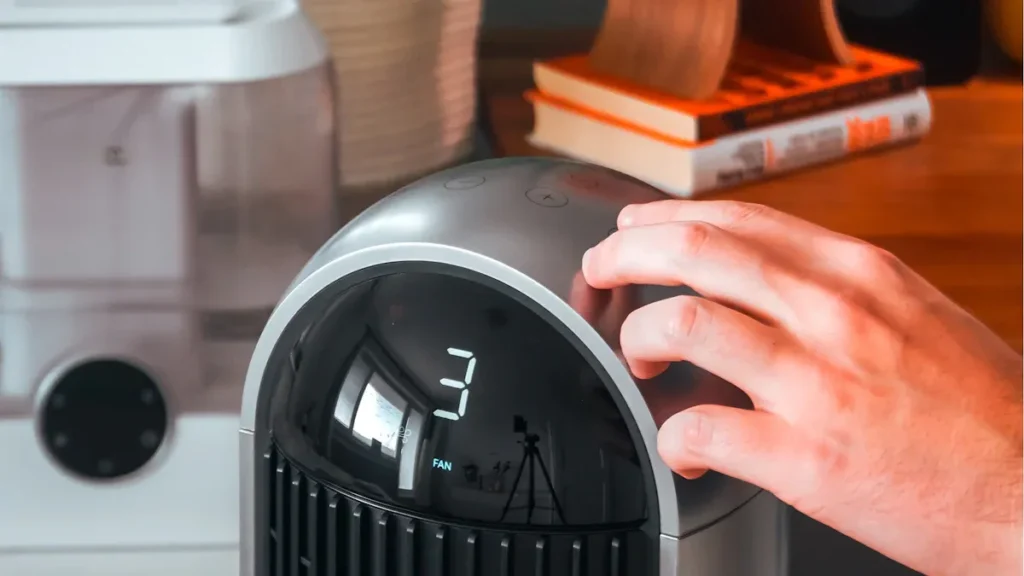
Bedrooms
When you choose an air purifier for your bedroom, you want clean air and quiet operation. Most bedrooms range from 100 to 224 square feet. For a 150 sq ft room, you need a minimum CADR of 100 (using the 2/3 rule: 150 x 2/3 = 100).
Noise level matters for sleep. The World Health Organization recommends keeping noise below 30 decibels at night. Some models, like the Honeywell InSight HPA5300B, run quietly even at higher speeds. Others, such as the Alen BreatheSmart, produce gentle pink noise at 49 decibels, which some people find soothing, but it is above the ideal level for sleep. Always check the noise rating before you buy.
Tip: Place the air purifier near your bed for the best results, but make sure it does not disturb your sleep.
Living Rooms
Living rooms are often larger, from 192 to 600 square feet. You need a higher CADR for these spaces. For example, a 300 sq ft living room needs a minimum CADR of 200 (300 x 2/3 = 200). The table below shows how to calculate CADR for different room sizes:
| Room Size (sq ft) | Minimum CADR Needed |
|---|---|
| 200 | 133 |
| 300 | 200 |
| 400 | 267 |
| 500 | 333 |
Energy use increases with larger models. Some air purifiers, like the Blueair 511i Max, offer high CADR with low power use (20W), making them energy efficient. Others may use more power for the same coverage. Look for models with auto mode to save energy.
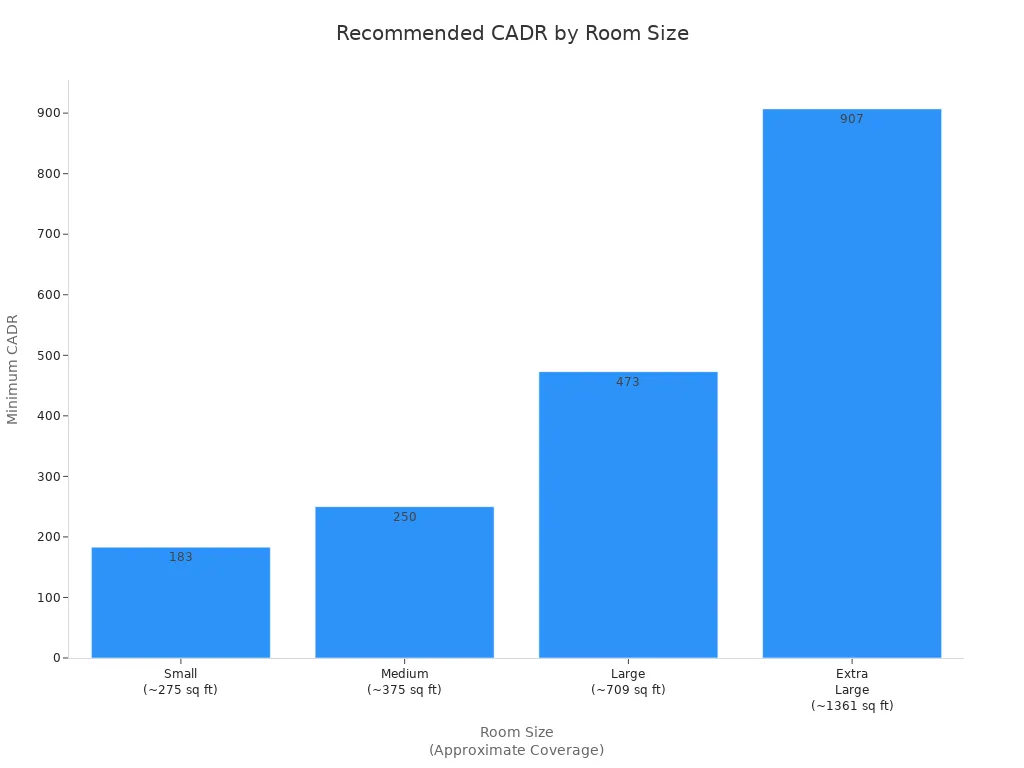
Offices
Offices come in many sizes. Small offices may be 90-150 sq ft, while large shared offices can reach 400 sq ft. Use the same CADR formula: for a 200 sq ft office, you need at least 133 CADR. High-occupancy offices need better filtration. HEPA filters with high MERV ratings (13-16) work best for removing dust, viruses, and bacteria. Pleated filters also help trap more particles.
| Office Type | Typical Size (sq ft) | Minimum CADR Needed |
|---|---|---|
| Small Private | 90-150 | 60-100 |
| Medium Shared | 150-250 | 100-167 |
| Large Private/Shared | 200-400 | 133-267 |
Note: Always match the air purifier’s CADR to your room size. If you pick a unit that is too small, it will not clean the air well. If you choose one that is too large, you may waste energy and space. Oversized units also cost more and are not needed for most homes or offices.
Tips and Mistakes
Noise and Energy
You want your room to stay quiet and your energy bills low. What can you do? Start by looking at how different models compare. Some units clean the air well but make a lot of noise. Others use more power than needed. The table below shows what you can expect from top-rated models:
| Model | Noise Level (dB) | Output (CFM) | Power (Watts) | Notes |
|---|---|---|---|---|
| Coway AirMega 400 | Very low | High | High | Quietest, best for large rooms |
| Winix 5500-2 | Quiet | Moderate | Moderate | Good balance, affordable |
| Coway Mighty | Quiet | Moderate | Moderate | Good for bedrooms and offices |
| Honeywell HPA100 | 68.7 | ~100 | Moderate | Louder at high speed |
| Honeywell AirGenius 5 | 56.1 | ~175 | Moderate | Quieter, tower design helps with airflow |
What helps you balance noise and energy?
- Use lower fan speeds at night or when you need quiet.
- Try auto mode if your unit has it. This lets the machine adjust speed based on air quality.
- Place your purifier away from walls and corners for better airflow and less noise.
- Clean or replace filters often. Dirty filters make the machine work harder and get louder.
Filter Types
What filter works best for your needs? HEPA filters trap dust, pollen, and even some germs. Carbon filters remove odors and gases. Some units use both. Always check the filter size and type before you buy. Make sure you can find replacements that fit your model. If you have allergies, look for a HEPA filter with a high MERV rating. For odors, choose a model with a thick carbon filter.
Tip: Replace filters on time. Old filters lower performance and can make the machine noisy.
Common Errors
What mistakes do people make most often?
- Picking a unit that is too small for the room. Many people trust the box, but real rooms need more power than the label says.
- Choosing a model that is too big. This can waste energy and make the room drafty or noisy.
- Buying the wrong filter size. Always check the exact size before you order replacements.
- Not checking the manufacturer’s specs. This can lead to buying filters that do not fit.
- Buying filters in bulk before testing one. You might waste money if they do not fit your machine.
Avoid these mistakes to keep your air clean and your machine running well.
To choose the right size, follow these steps:
- Measure your room’s length, width, and height.
- Add up areas if you have connected rooms.
- Pick a HEPA-certified model.
- Match the CADR rating to your room’s needs.
- Focus on filtration power, not just the machine’s size.
- Avoid oversizing unless you have special needs.
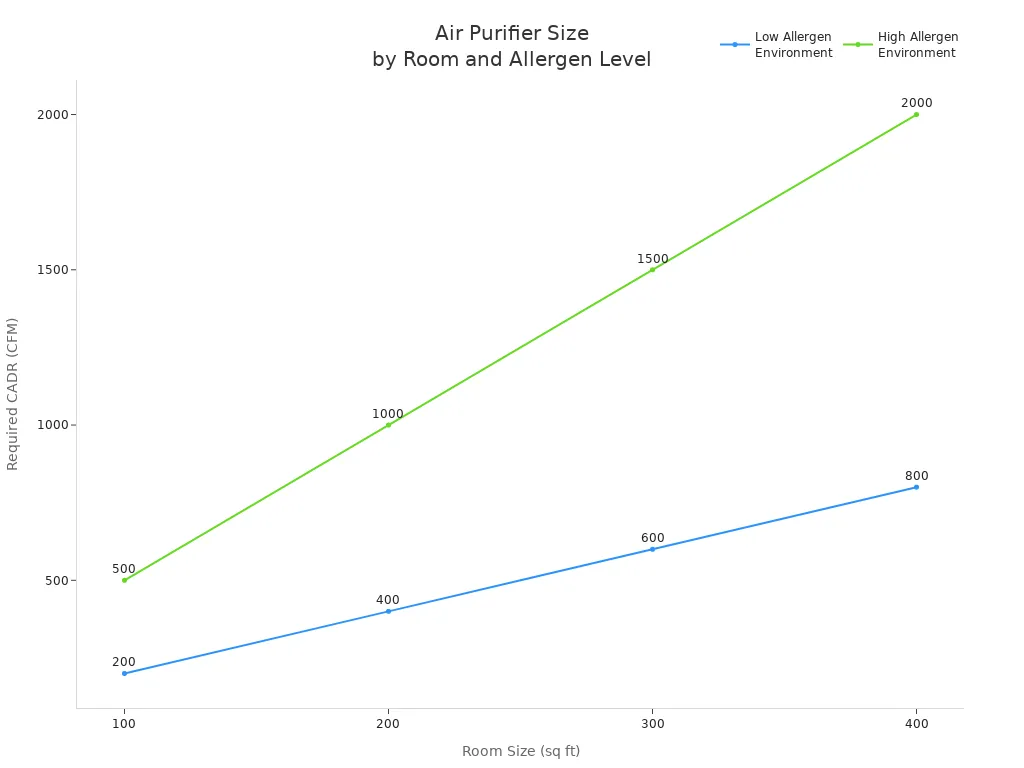
Using the right size helps you breathe cleaner air and supports better health. Try the formulas and tables above for your space. If you have questions or want to share your results, leave a comment below!
FAQ
What happens if you use an air purifier that is too small for your room?
You will not get clean air in your space. The purifier cannot remove enough dust or allergens. You may still notice odors or feel allergy symptoms. Always match the purifier size to your room.
What is the best place to put an air purifier in a room?
You should place the air purifier near the center of the room or close to where you spend the most time. Keep it away from walls and corners. This helps the machine clean the air more evenly.
What kind of filter should you choose for allergies?
You should pick a HEPA filter. HEPA filters trap dust, pollen, and pet dander. If you have strong odors, choose a purifier with a carbon filter as well.
What is the difference between CADR and ACH?
Note:
CADR shows how much clean air the purifier delivers each hour. ACH tells you how many times the air in your room gets cleaned in one hour. Both help you pick the right size.
What maintenance does an air purifier need?
You need to check and replace filters regularly. Most filters last three to six months. Clean the outside of the unit with a dry cloth. Always follow the instructions in your user manual.
See also
How Air Purifiers Maintain Clean Air in Modern Homes
Whether one air purifier can be suitable for multiple rooms
What to Consider Before Putting an Air Purifier in Every Room
